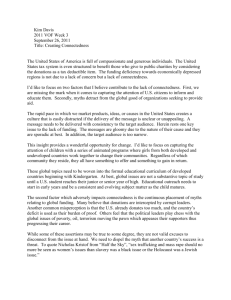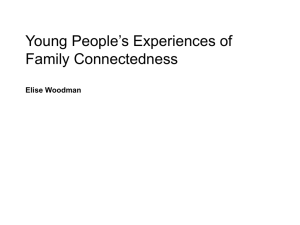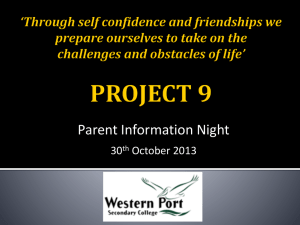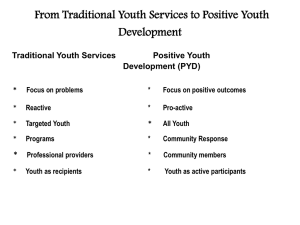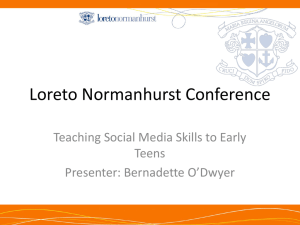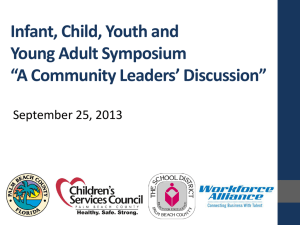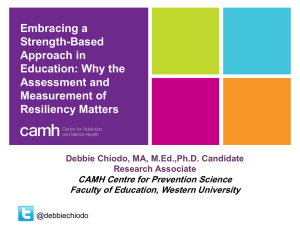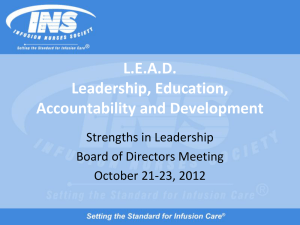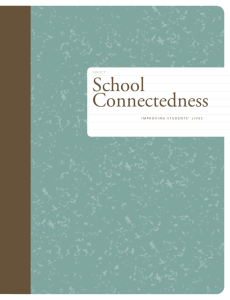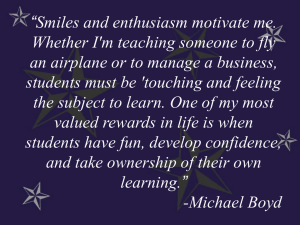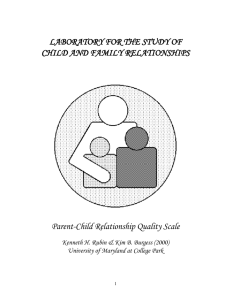School Connectedness-Dr. Blum Presentation
advertisement
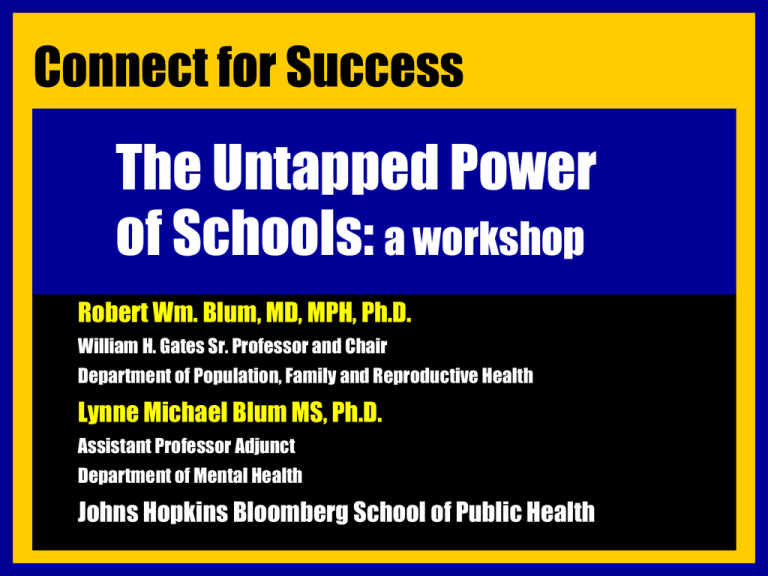
Connect for Success The Untapped Power of Schools: a workshop Robert Wm. Blum, MD, MPH, Ph.D. William H. Gates Sr. Professor and Chair Department of Population, Family and Reproductive Health Lynne Michael Blum MS, Ph.D. Assistant Professor Adjunct Department of Mental Health Johns Hopkins Bloomberg School of Public Health Session 1: Why School Connectedness? What is School Connectedness? How does it impact behaviors as well as education? Why does it matter? What is school connectedness? •Sense of belonging, being part of school; •Liking school; •Perceiving teachers as supportive and caring; •Having good friends at school; •Being engaged academically; •Experiencing fair and effective discipline; •Participating in extra-curricular activities. Prior research from Add Health has shown a strong association between school connectedness and every risk behavior Methods The Sample The National Longitudinal Study of Adolescent Health A stratified random sample of 80 high schools with primary feeder schools N=134 schools (127 participated in school survey) N=71,515 students in 7th through 12th grade N=127 school administrator surveys Methods School Characteristics Size 42 to 5422 (average=642) Public 82.7% Class size 10 to 39 (average=23) Location Rural Suburban Urban 18.6% 59.6% 21.8% Substance Use Students who feel connected to school are less likely to use substances Level of Substance Use (SD Units) 1.5 1 Frequency of Use: Alcohol Cigarettes Marijuana 0.5 0 -0.5 Not at All Very Little Somewhat Quite a Bit Levels of connectedness Very Emotional Distress Students who feel connected to school experience less emotional distress Level of Emotional Distress (SD Units) 1.5 1 Emotional Distress Suicide 0.5 0 -0.5 Not at All Very Little Somewhat Quite a Bit Levels of connectedness Very Violence or Deviant Behavior Students who feel connected to school engage In less violent or deviant behavior Level of Violence or Deviant Behavior (SD Units) 1 0.5 Deviant Behavior Violence 0 -0.5 Not at All Very Little Somewhat Quite a Bit Levels of connectedness Very Pregnancy Students who feel connected to school are less likely to become pregnant Percent ever Pregnant 24 22 20 18 16 14 12 Not at All Very Little Somewhat Levels of connectedness Quite a Bit Very Results Factors Associated with School Connectedness THE SCHOOL School size mattered …classroom size did not School type is not associated with connectedness …public, private, parochial Location of school is not associated with connectedness …urban, suburban, rural Results Factors Associated with School Connectedness TEACHERS Teacher experience was not associated with connectedness. Having a master’s degree was not associated with connectedness. Results Factors Associated with School Connectedness SCHOOL CLIMATE & Teacher Engagement/ Caring The single strongest association with connectedness was school climate Initiated Cigarette Use Predicted Percent at Three Levels of Teacher Support 18 16 14 12 10 16.5 14.3 12.2 - 1 s.d. Mean + 1 s.d. 8 6 4 5.3 2 0 None to Occasional 3.8 2.8 None to Regular Multinomial logit models adjusted for social belonging, race/ethnicity, income, gender, family structure, emotional distress, relationship with parents, hx of peer suicide, hx of family suicide Initiated Getting Drunk Predicted Percent Three Levels of Teacher Support 18 16 14 12 10 13.4 11.3 - 1 s.d. Mean + 1 s.d. 9.5 8 6.2 6 4.5 4 3.2 2 0 None to Occasional None to Regular Multinomial logit models adjusted for social belonging, race/ethnicity, income, gender, family structure, emotional distress, relationship with parents, hx of peer suicide, hx of family suicide Seriously Considered or Attempted Suicide Predicted Percent at Three Levels of Teacher Support 18 16 14 12 10 - 1 s.d. Mean + 1 s.d. 8 6 4 5.5 5.0 4.5 2.2 1.7 2 0 None to Ideation 1.3 None to Attempt Multinomial logit models adjusted for social belonging, race/ethnicity, income, gender, family structure, emotional distress, relationship with parents, hx of peer suicide, hx of family suicide Initiated Violence Predicted Percent at Three Levels of Teacher Support 18 16 14 12 - 1 s.d. Mean + 1 s.d. 10 8 6 4 7.5 6.0 4.7 2 0 Multinomial logit models adjusted for social belonging, race/ethnicity, income, gender, family structure, emotional distress, relationship with parents, hx of peer suicide, hx of family suicide Students are Disengaged By high school, 4060% of all students are chronically disengaged from school. Klem & Connell, 2004 Students are more likely to be connected to school when expectations are… •High •Fair •Clear Engaged students are more likely to… •Pay attention; •Do more than is expected; •Have higher grades and test scores. The Academic Benefits of Teacher Support Comparing academic advancement in reading and math among 3rd graders with high and low teacher support: Reading: 1.5 yrs vs. 0.5 yrs advancement Math: 1.67 yrs vs. <1 yr advancement School Disengagement Two thirds of all teens who wind up pregnant or in the juvenile justice system have early warning signs of school disengagement The Relationship Between Skipping School and Later Delinquency (OR) ONSET OF SERIOUS CRIMINAL CRIMES Class Skipper 4.12 Minor Truant (1-3 days) 4.03 Moderate Truant (4-9 days) 6.84 Chronic Truant (>9 days) 12.15 School climate, teacher caring, and social connectedness are closely intertwined. Connection Matters Second to home, school is the most important environment in the lives of young people. Feeling engaged at school is critical for both academic and social success. Wingspread Declaration “Students are more likely to succeed when they feel connected to school. School connectedness is the belief by students that adults in the school care about their learning as well as about them as individuals." By the end of today… We will work together to build strategies for your school and classroom Before lunch Interpersonal Connectedness Assessing School Climate and Connectedness After lunch Physical and emotional safety Academic Engagement Section 2 INTERPERSONAL CONNECTEDNESS Making School Connectedness Happen The Triad of School Engagement Triad of Engagement Interpersonal connectedness with school An engaging environment that is physically staff and peers and emotionally safe Academic engagement - high expectations, support for learning, and flexible, relevant instruction The elements of the Triad are highly interrelated When schools excel in the triad of engagement, students feel supported, safe, and capable of solving academic and personal challenges. Create personal connections When school fosters positive relationships between students and adults a climate of respect and safety is created which in turn fosters student academic engagement. When students feel connected to at least one significant adult in their education, they experience: Positive academic attitudes and values Satisfaction with school Engagement in academic work Better school attendance Learning Better academic performance What teachers can do to create connectedness Know each student’s educational strengths and weaknesses so as to maximize strengths. Use assignments to encourage students to share stories about themselves. Establish a regular time at least weekly for students to share thoughts and concerns. Ask questions and spend time listening. Adults who connect… Listen Compliment Are not guided by prejudice Do not assume Treat students fairly Adults who connect (cont.)… • • • • Get to know their students' needs Are welcoming Respect students' input Show each student they believe in them Adults who connect (cont)… Treat students with respect: public compliments and private, supportive corrections. Advise and mentor students: meet one-onone with students to work on goals. Empathize with and coach students who face problems. Individual Exercise Take 3-5 minutes and jot down on a piece of paper one strategy that you use or know of that would provide a personalized touch between yourself and students in your class or school. Share your idea: pass it to the person next to you. 2:1 For every one dose of adult directions and lecture, take two doses of kid discussion and conversation. The goal is to lecture less, talk less, direct less and… Ask more questions using reflective listening. Wait for a response when a question is asked because sometimes kids are slow to respond. Dare to get personal Get to know your students personally-not only their academic faces, but their personal faces. Make the classroom and the school a place where kids feel you know their stories and you know what’s happening to them. A Personal Touch Make sure that there is someone who knows every student by name; Greet students by name in the hallways, classroom, lunchroom, as they get off the bus. Look students in the eye Hibbin’s Story I went to a big school where many adults never learned my name. On the first day of sixth grade, I was met outside the building by the new school principal. As he greeted all the students, he said to me, 'Hi, I'm Mr. So and So and I'm glad you're here; welcome back.' I was shocked….It made me feel I belonged to a place where people cared whether or not I was there. A strategy for elementary school children At start of the year students write a few paragraphs about themselves, their family, likes and dislikes Students are encouraged to bring in photos that can be scanned into the document The document can be printed and provided to students and parents The document can be added to over the school year Other personalizing strategies for elementary school children VIP Day (or week): where every student has a day or week where they are the focus of the class– bring in pets (or photos), family members, songs, clothes and food from their family’s country of origin Personal Crest: with 4 quadrants: likes and dislikes (e.g., food), favorite class, self portrait, family portrait Personalizing strategies for elementary and middle school Have students compile a guide for new students that introduces the school from a student perspective. Use cross-age mentoring e.g., middle grade students with elementary Personalizing strategies for Middle school years (cont)… Use writing assignments such as: “If I were principal….” Have students create a time line of their lives– major events (from their perspectives) and post them on the walls. Recognize and celebrate achievements large and small. Personalizing Strategies for High School Students Be willing to provide honest, clear, and nonjudgmental feedback on personal behaviors (e.g., “I am concerned since I often smell cigarette smoke on your clothes…”) Indicate your availability to listen by asking questions (e.g., “I have been concerned since you often look sad and distracted. What’s up? Can you talk about it?”) Other strategies that personalize the school environment Help students develop behavioral and academic goals and provide a monitoring and reward system. Use popsicle sticks to call on students rather than having them raise their hands. Create a goal for yourself such as to increase praise or develop new approaches to critical feedback. The Teacher of the Year When asked what she did to become the Teacher of the Year, a New Jersey school teacher said: “ I made it my goal that between Thanksgiving and Christmas I would call every parent in my class to say one thing nice about their child. For some it is the only positive call they ever got from school.” Personal Concern starts at the top The evidence is clear that when the school leadership is concerned about staff, they in turn are more likely to show concern for the students. Evidence-based ways to structure the school environment to enhance personal connections Create a small school culture -"schools-within-a-school" Use multidisciplinary team teaching, instead of changing (i.e., small learning communities, magnet schools, or career academies). classes. Teachers are given prep release. Use paraprofessionals Implement looping: Have the same groups of teachers Every teacher a mentor: use group mentorship formats stay with the same students across the school day and school years. Small Group Activity: At your table take a large post-it sheet and fill in the table below (10 min.) Ex: 1 2 3 4 Interpersonal Connection obstacles in school/classroom Proposed solutions There is no time in the school day to personally connect with students. Once a week, have “Lunch Bunch”: invite kids to bring their lunches to your classroom to eat and play games. Section 3 ASSESSING SCHOOL CONNECTEDNESS IN YOUR SCHOOL What data does your school have to assess climate and connectedness? School Climate data from: students teachers parents What data are missing? Whose voice is most important in assessing school climate? What matters most in collecting more information: process or data? In Your School…. How will you know if students in your school are connected? How do you measure it? What can students do to increase connectedness to school? Improve climate? What about teachers, what can they do? Administrators? Parents? Activity (10 min) Discuss with your team what information you think is needed that you do not have so as to improve school climate. Why is it needed? And from whom should you get it? Frieberg’s Assessment of School Climate Noise in the lunch room Hallway monitor treatment of students who are where they don’t belong The presence (or absence) of doors and toilet paper in bathroom stalls Grafitti on school walls School Climate Assessments: categories for consideration Safety (physical, emotional, academic) Bullying/Teasing/Social Isolation Trust/Respect/Caring Racism and racial segregation Parent/School relations School Connectedness Commitment (e.g., school spirit) Attachment/Belonging Involvement/Participation Belief about school rules and policies Power and Authority Central Themes of School Connectedness Academic Engagement Belonging Fairness of rules Liking School Student Voice Participation in activities Peer relationships Safety Teacher support Small Group Activity (10 min.) Looking at the various types of information that can be collected that relate to school connectedness and school climate, which do you think will be most important for your school and why? Large Group Activity Lunch Section 4 The Triad of Engagement: Creating a Safe Environment THE BEHAVIOR SAFETY ZONE THE SOCIAL-EMOTIONAL SAFETY ZONE Creating a Behavior Safety Zone Connectedness increases when The lunchroom, playground, and hallways are emotionally and physically safe, not behavioral minefields for students. Unstructured common area activities are monitored by staff members who ensure respect and order. Noise levels are moderated in shared spaces. Creating Pride in the School Facilities Decorate common spaces with student art Clean graffiti immediately Rotate the assignment of maintaining aspects of the facility, creating a peace garden Establish a parent volunteer group for beautifying the school grounds Hold school clean up day in conjunction with Earth Day or planting shrubs and trees in conjunction with Arbor Day. Establish a protective discipline system • Provide a fair and just discipline program • Involve students in creating the system • Consistently to enforce consequences • • Engineer the discipline system so that it is compassionate, teaches appropriate behavior and allows for corrections Ensure that ALL adults in school are accountable for respectful behavior toward each other and students Positive Behavioral Interventions and Supports (PBIS) PBIS emphasizes changing the school environment, teaching new skills, modifying student and adult behavior, and removing the secondary gains that tend to come with problem behavior. Establishes uniform expectations and rules for student behavior and posts those rules; Teaches students appropriate, pro-social behaviors; Rewards students when they are "caught doing something good." PBIS VIDEO What Teachers can do Establish a behavioral Magna Carta for the class together with students Use infractions as teaching opportunities Provide respectful and clear feedback Use non-aggressive strategies to correct or extinguish unacceptable behavior School as an Arena of Comfort CREATING A SOCIAL AND EMOTIONAL SAFETY ZONE Individual Activity (3-5 min) When you think of school as an emotional safety zone, what kinds of things come to mind? List 2-3 things that you could do to enhance school as an emotional safety zone. Creating School as an Arena of Comfort Create a cultural celebration day where students can share the language, food, costumes, and culture of their family’s country of origin Showcase everyone’s work… not just the “best” in the class Use the “popsicles” or fishbowl to call on students rather than hand raising Provide a “complaint box” where students can share their concerns Safe to make mistakes Encourage "redo's" on papers and tests. Remember, the goal is that students learn not that they get it right the first time around Make time to meet with students to help them learn from mistakes Provide correct responses when grading papers Never tolerate students making fun of others who get answers wrong Create an environment of tolerance for all levels of learning Use the classroom and playing field to teach conflict resolution Use role play to explore conflict resolution options Use literature and history and discuss alternatives to resolving the conflict Use conflicts that arise at school as teaching moments to explore possible alternatives that could have been learned The school should be safe from bullying Boys are more likely to bully through physical aggression and girls through isolation Discuss bullying at PTAs and encourage parents to inform school when they suspect their children are being victimized Teach respect and coping skills in the classroom School-wide Inclusiveness Programs Implement a student-run, year-round welcome programs for new students Create structures that enable friendships by increasing students' social awareness. Implement social and emotional learning programs to help create social awareness among students Provide alternatives to lunchroom loneliness: Run club meetings during lunch where students can take their lunches and work on the club activities or create a lunch bunch where activities are held. Structure activities on the playground (for younger students), led by older student volunteers who can run structured play activities. And now… … A BREAK Section 5 ACADEMIC ENGAGEMENT Three Elements of Academic Engagement 1. Set high academic and behavioral standards. 2. Implement flexible teaching methods. 3. Make subjects relevant. Center for the Social Organization of Schools Johns Hopkins University School connection is the belief by students that adults in the school care about their learning as well as about them as individuals. The critical requirement for feeling connected include students’ experiencing… •High academic expectations and rigor coupled with support for learning; •Positive adult-student relationships; •Safety: both physical and emotional. #1 Set high behavioral and academic standards Provide school-wide tutoring and other learning supports Provide school-wide academic incentive programs based on “as soon as” strategies Provide supports for teachers that frees them from trivial administrative tasks so as to focus on individual assessment and instruction Establish individual student educational goals and monitor progress toward them Establish Professional Learning Communities This strategy provides an environment fostering collegial support and "synergy of efforts." Staff teams meet regularly to receive training and assist one another in planning more effective lessons, critiquing student work, and solving the common problems of teaching. For more information, visit www.nsdc.org, National Staff Development Council. Low Expectations of Students… Is commonly experienced by students Sends the message of incompetence Is seen as disrespectful by students Can lead to a school environment characterized by disrespect The key elements of an effective school High Expectations coupled with High Supports High Expectations help students achieve their Personal Best Expectations and support have to be determined student by student. Expect students to reach their personal goals, not necessarily the goals for average students. Support underachieving as well as gifted students and help them meet their highest personal best Grading Allow re-tests and re-writes… the goal is information acquisition and skill development not test proficiency Provide the correct responses so that students can learn from errors Make time to meet with students after class or school to provide feedback #2 Flexibility is key Students don’t all learn in the same way or at the same pace School leaders that encourage teachers to adapt teaching styles to mesh with learning styles and needs of students create supportive learning environments Reward teachers for innovative teaching methods School systems that encourage flexibility… Provide teacher training, in-service opportunities, and coaching to help teachers keep pace with innovative instructional methods. Encourage teachers to address all learning styles. Vary their assessment methods to meet the needs of the students. Use strategies to encourage use of higher-level reasoning skills, not just memorization skills. Adjust the curriculum to accommodate to transfer students. Accommodate to the learning needs and strengths of students Accomodation Schools that accommodate allow students to demonstrate what they know using the modalities that work best for them. This may mean: --oral examinations --untimed testing --separate room for testing of highly distractible students Raising Healthy Children Raising Healthy Children is a program that engages the emotions, elements of movement and novelty during learning. It encourages questioning. One strategy is: Think-pair-share where, during oral language exercises, students "think" by correcting mistakes in the sentences, "pair" with a partner to explain their corrections, and then "share" the correct answers with the class. #3 Relevance and learning We learn when the information has meaning in our lives. Relevance comes through getting students involved in their learning. Relevance comes when knowledge is drawn from the students’ life stories. Relevant Instruction If there are students with chronic illnesses or disabilities in the class teach history by including influential figures with those conditions. Read literature about heroes who the students can identify with. Teach writing by having students write their autobiographies and/or keep diaries Engaging schools use Active Learning Active learning places students in activities that demand decisionmaking and problem-solving skills (for example, it uses assignments where students need to investigate answers, interview people, visit sites, and report back). Service Learning makes instruction relevant It provides an opportunity for hands-on learning and perspective taking It teaches skill-building Through problem solving it builds selfefficacy By helping others it builds self-esteem To be effective there must be adult mentorship and an opportunity to process experiences Service Learning is associated with… Lower dropout and suspension rates and improved engagement with school Less alcohol consumption Improved attitudes toward older people Increased civic engagement as adults Increased attention to the news Better work attitudes Increased attendance and persistence in schoolwork. Small Group Activity (10 min.) In your group, brainstorm two or three examples of Academic Engagement strategies: How to communicate high expectations Increase flexibility of instruction Increase relevance of instruction Section 5 CONCLUSION Positive school climate includes… • • • Emphasis on academic achievement; Positive relationships between students and teachers; Respect for all members of the school community; • Fair and consistent discipline policies; • Attention to physical safety; • Family and community involvement. Connected students… • • Like school; Say that teachers provide positive feedback; • Say teachers listen to them; • Believe that all students are treated fairly; • Feel safe; • Don’t experience prejudice. Characteristics of Well-managed Schools and Classrooms Expectations are clear for individual responsibility and conflict resolution Teachers consistently acknowledge all students Students are actively involved in classroom management Discipline is authoritative not authoritarian Social integration of students is structured Increasing the number of students connected to school is likely to impact critical accountability measures, such as… Academic performance; Incidents of fighting, bullying, or vandalism; Absenteeism; School completion rates. Strong scientific evidence demonstrates that increased student connection to school promotes 1. Educational motivation; 2. Classroom engagement; 3. Improved school attendance. These three factors in turn increase academic achievement. These findings apply across racial, ethnic and income groups. Creating Conditions for Learning Students are supported Students are socially capable Meaningful connection to adults Strong bonds to school Emotionally intelligent and culturally competent Positive peer relationships Effective and available support Responsible and persistent Cooperative team players Contribute to school and community Students are safe Students are challenged Physically safe Emotionally and socially safe High expectations Strong personal motivation Treated fairly and equitably Avoid risky behaviors School is safe and orderly School is connected to life goals Rigorous academic opportunities Their Futures are in your hands!
